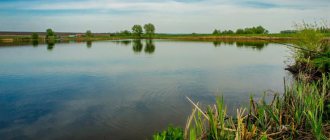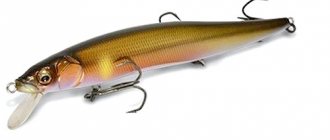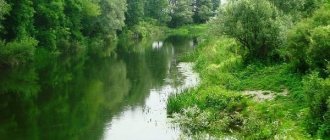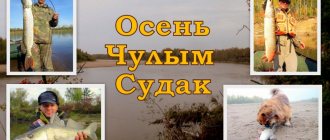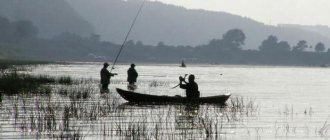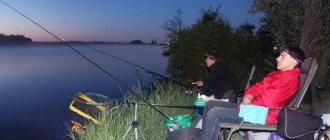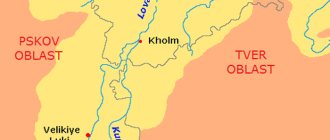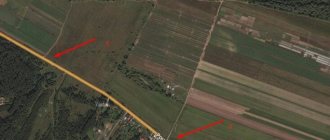Fauna in reservoirs
The local river fauna will delight any fisherman with its diversity. Depending on the time of year, fishing in Orel can bring a wide variety of trophies, from large roach to massive specimens of pike or pike perch. The type of prey will depend on the choice of place for fishing, for example, it is better to catch predatory fish in the lower reaches of the river. Large catfish love shady places, deep water, and muddy reservoirs.
The species of aquatic inhabitants are striking in their diversity: predatory and herbivorous fish, of which there are about 30 species in the waters of Orel. In lakes and rivers of the Oryol region the following are especially often caught:
- Perch,
- Bream,
- Roach,
- Chub,
- Carp,
- Silver and gold crucian carp,
- Carp,
- Ide.
Predatory representatives of fish families, for example, catfish, pike, pike perch, and burbot, are also common in local waters. The most successful fishermen manage to get their hands on rarer trophies: bleak, loach, grass carp, sterlet, sturgeon, bluefish. Such fish are not easy to find in public fishing places , but at paid fishing bases the likelihood of getting a rare specimen is very high.
The success of the catch largely depends on the seasonality of fishing in Orel, the depth of the reservoir, the speed of the current, the type of fishing, and the location. You can fish from a boat or from a convenient river bank, using a spinning rod, bottom tackle, or a float rod, using a wide variety of bait and groundbait.
Fishing on the Oka
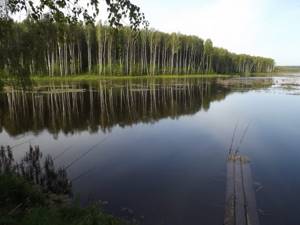
Oka in the Oryol region has an average depth of three meters. More than 30 species of fish live in its waters. But most often the catches include roach and bream. They fish both from a boat and from the shore. Rafting fishing is the most popular. Fishermen go with the flow and catch interesting places.
In our region, the summer fishing season begins in April and ends at the end of the first month of autumn. The river is rich in rifts where you can catch asp, chub, pike perch and dace. The pools and pits are home to fish species such as burbot and catfish. There is also silver carp in Oka, but it’s difficult to catch. Pike hunt along the coast. It bites well and actively on spinning baits.
With a reverse current in the holes you will find silver bream and husk. The fish reacts remarkably well to bait and stays on the feeding spot all day. In those areas where algae grows there are a lot of roaches. Of course, the size of the fish is not encouraging, but it is abundantly distributed throughout the river. Bream can be caught well at night. Trophy fish also bite well at this time.
Free fishing spots
Fishing in Orel can be free or paid; of course, most fishermen prefer public fishing places. Most of the water bodies in the city are represented by rivers, which are the basins of the Dnieper, Don, and Volga. The most popular among fishermen are:
- One of the largest European rivers, the Oka,
- The winding, deep-water, fast-flowing river Sosna,
- Zusha is the right tributary of the Oka, characterized by steep banks with rocks and cliffs,
- Navlya is a western tributary of the Desna.
It is worth noting that rivers are not the most favorite places for Oryol fishermen. In winter and summer, fishing is good on local lakes: Zvanom, Indovishche, Lavrovsky and others. Each of them contains many species of fish. But, before you go fishing, you should familiarize yourself with some of the fishing restrictions that are found in Orel’s reservoirs.
Features of fishing on the Oka
The largest river flowing in the Oryol region, of course, is the main reservoir for fishing. The river attracts local and visiting fishermen with its winding channel, fast-flowing and calm sections, numerous branches and branches.
Oka cannot boast of great depth, but this does not affect the number of species of underwater inhabitants. The river depths hide about 30 species of fish. The most desirable trophies that every fisherman can get are large specimens of ide, bream, asp, burbot, and catfish. Despite the huge population of all these fish, the angler should carefully choose a place for fishing so that it is as productive as possible.
Fishing on Zoucha
In second place in popularity among fishermen is the Zusha River, which originates in the Tula region. The river mouth flows into the Oka River near the small village of Gorodishche. The length of the river is 234 km.
The main difference of this reservoir is its shallow depth (maximum 2-2.5 meters) and rapid water flows, steep rapids and steep coastline. There are no bays here, so you won’t be able to find fish in Zoucha that like calm currents. In addition, the river has several tributaries:
- Neruch,
- Snedezh,
- Black.
Fishing on the Zusha River is often accompanied by family vacations for local residents. Despite the turbulent current, the water here is very clean and transparent, and the nature is very picturesque. Fish diversity can bring the fisherman several trophy specimens of asp, pike, pike perch, and chub. But the most frequent bite belongs to smaller fish: roach or perch. The advantage of this reservoir is its excellent roads, which provide fishermen with convenient access almost to the water itself, as well as numerous “fishing spots”.
Capture on Lake Zwano
Winter and summer fishing is especially good on Lake Zwano. Every day it is visited by dozens of amateur and professional fishermen due to the diversity of aquatic fauna. The deep-water reservoir (its depth in some places reaches 18 meters) is located 70 km from the center of Orel, in the Shablykinsky district of the city. Previously, on the site of the lake there was a quarry, to which Zvanoe owes its depth.
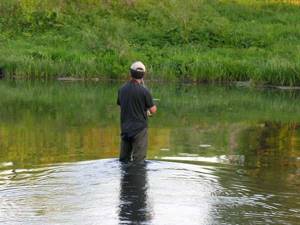
This place is attractive for local fishermen and guests of the Oryol region due to the variety of fish species and free fishing. The desired trophy for the fisherman here are large catfish, which are distinguished by their aggressive behavior when hooked, which develops even among professionals a serious sporting interest. The most common fish on Lake Zvanoye are crucian carp, large pike and sneaky loaches. You can read more about fishing on the lakes and rivers of the region on the special Fion Orel forum, where experienced fishermen share their experiences and successes every day.
Zusha River
I decided to start this fishing trip around the Oryol region on the banks of the Neruch River and then, from its mouth, walk along the Zushi - the river about which it was written in Turgenev’s “Notes of a Hunter,” familiar from my school years. Backpack, tent, gear - the set is usual. There is a week of vacation ahead, and this means a couple of tens of kilometers of walking, spending the night by the river, fishing hopes.
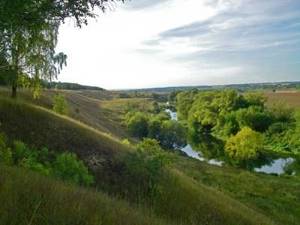
Zalegoshch station. The three-car train, having stood for the required two minutes, continued its leisurely progress. From here, on a cloudy morning, my acquaintance with new places began. The Neruch River greeted us with clear water and old willows. The pools overgrown with water lilies and cattails give way to rocky rapids with melodic water jets. The width of the river is small: ten to one and a half meters. Dahl's dictionary says that the word neruch in these places means “big stream” or “small river.” For a couple of kilometers, I carefully fished all the places available for spinning casting. Lures are small spinners and chub wobblers. Unfortunately, I didn’t experience the joy of a bite. The cause was most likely a powerful northern cyclone with rain and strong winds. A few local fishermen said that they mainly catch roach in Neruchi. The bait is simple and easily accessible for the Black Earth Region - steamed wheat. Closer to autumn, as the water cools, kilogram pike begin to be caught on live bait.
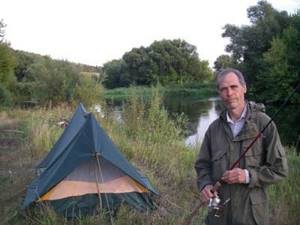
Although there are other fish in the river - white bream, chub and even asp, they do not fish near the mouth, preferring to fish nearby, on the large and fishy Zusha. Having received the Neruch, the already full-flowing Zusha here spills into a wide riffle with shallows and islands, favored by flocks of domestic geese. After half a day of walking along the river bank, it became clear to me: Zusha is Neruch’s sister, but the older sister. The same clean spring water, the same meadows and wooded steeps, rifts and quiet places. Only it’s all bigger, wider, deeper. The river is sometimes fast and shallow, sometimes calm with dark depths. I camped on the shore in three places, and everywhere Zusha was different, different. This is the foot of a high cliff, overgrown with linden and hazel, and a birch grove on a hillock, and a meadow cliff with many swallow’s nests.
In general, this area is black soil in the truest sense of the word: the soil is very dense, there are many country roads. We can say that these are ideal conditions for traveling by car in any direction. Hence the relatively high number of visitors to the banks of these rivers. Yes, you can’t call them deserted. Along the shore, as a rule, there is a well-worn path and many approaches to the water. And where there is an entrance, garbage and other consequences of the presence of fishermen and simply vacationers are common. I also came across jeeps with Moscow license plates. But mostly they come from Orel and Mtsensk. Although there are many convenient places with access, especially on the meadow banks, this does not mean that they are all always occupied. For example, no one bothered me with my close proximity. I was even glad when one day a Lada drove up to my camp. We met. It turned out that one of those who arrived was an underwater hunter from Mtsensk. He hunted for two hours in a wetsuit. By the way, the transparency of the water in both Neruch and Zusha is very high; visibility with a mask under water reaches five meters.
A spinner on Zoucha never gets bored. And is it possible to remain calm when there are splashes here and there when small things are scattered and the movement of the water does not immediately subside due to the maneuver of a large fish? There is fish in the river, and the fish is good. But taking the trophy on Zoucha is not easy. A large chub, and basically it is the breaker of silence on reaches and riffles, rarely strikes in one place, moves a lot, and most importantly, is very careful. Over the course of a week of fishing, I was not able to seduce a single one with my wobblers and spinners. But he was not left without a catch. At dawn I caught a good perch, and my biggest fish was probably a half-kilogram asp, which, of course, was released.
The best of the baits turned out to be wobblers with a small depth of up to half a meter, which made it possible to do wiring in shallow places with an overgrown bottom. On Zoucha, in addition to spinning anglers, you can meet fans of fishing with tackle with a long release of the float. They fish from the shore. Having chosen a convenient, not the deepest and fastest place, they float downstream up to thirty meters a tackle with a mounted bunch of “tinki” and a large, clearly visible float. Their reward is a well-fed, beautifully colored roach. In general, there are few local fishermen. Yes, it probably cannot be otherwise, because the villages here are far from prosperous, and few people live in them. In all this time I have only met three people. One was catching roach on wheat on Neruchi, the other was on Zush, in Izmailovo, threw a large spinning rod for half an hour and finished fishing. The third one was also caught near Izmailovo with a long release of the float. The week flew by unnoticed. Morning of departure. The gear has been collected and the tent is already in its cover. And let the trophies be small. Fishing is not just about catching fish. I will remember the distance of fields with stripes of forests, and the vast willows near the water, I will also remember the unexpected encounter in Vyazhi - such a remote place! - rural museum. And I began to understand Turgenev differently...
Zusha River
Right tributary of the Oka. The river originates in the Kamensky district of the Tula region. It flows in a southwestern direction, then, near the city of Novosil, it turns quite sharply to the northwest and flows into the Oka River near the village of Gorodishche, on the border with the Bolkhovsky district of the Oryol region. The length of Zushi is 234 kilometers, the width at Novosil is 30 m, in the Mtsensk region -40-80 m, the depth on average is 2 m. The banks are often steep, there is no wide floodplain; The current is fast and sometimes rapids. Freeze-up from early December to late March. The river is fed predominantly by snow; the water flow in the middle reaches near Mtsensk is about 28 m3/s.
The main tributaries: Neruch, Chern and Snezhed. Previously, Zusha for 35 kilometers, from the city of Mtsensk to the confluence with the Oka, was used for shipping. In the 1950s, hydroelectric dams were built on the river: Vorotyntsevskaya, Novosilskaya and Lykovskaya, now abandoned.
Paid fishing bases
Many fishermen prefer fishing in Oryol and the region at paid fishing bases. Such places have quite a lot of advantages:
- Cleanliness of the territory and the reservoirs themselves,
- Comfort,
- Improved access to the water,
- Providing or renting gear, additional equipment, such as boats,
- Secure car parking.
The determining factor when choosing paid fishing bases is the variety of fish, because these are, in a way, fish farms. In addition, most of the paid reservoirs are located in close proximity to the city center. In the city of Orel, fishing is most popular at the bases EcoOstrov, Kokarevo (U Zubka), Romanovsky Pond and others.
Infrastructure and conditions of Eco-Island
This place is one of the paid fishing bases where there are restrictions. Each fisherman is allowed to use only one tackle with two hooks. Fishing is carried out here only during the day. At this time, the fisherman will be able to catch large carp, carp, grass carp and other fish. As for the size of the reservoir, it is small, only 600 meters in length. The maximum width of the pond reaches 200 m, the minimum is only 100 meters, and the depth in some places is 4 m.
In addition to fishing, the EcoOstrov recreation center will be an excellent place for a family or group outing. Beautiful landscapes, tidy territory, cozy gazebos and even houses for the night. The administration provides all this to its visitors. Here you can rent a boat or catamaran, barbecue, and buy only caught fish. The EcoOstrov base is located near the Oryol village of Shakhovo. The cost of a day pass per person is 500 rubles.
Recreation center "U Zubka"
It is located in the Znamensky district of Orel (approximately 30 km from the city center), in the village of Kokorevo. Convenient access allows visitors to easily get to the reservoir directly by car. The main advantage of this fishing base is a single payment rate, regardless of whether the visitor uses the gazebo or rooms in guest houses or not. The environmental fee also includes a fee for caught crucian carp. But you will have to pay extra for caught grass carp and carp (payment is charged not by piece, but by weight).
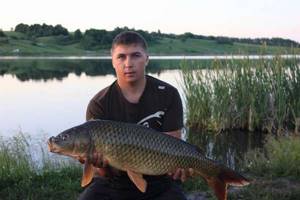
The base “U Zubka” is located in an ecologically clean area, surrounded by dense forests. You can combine fishing on the pond with relaxing in gazebos, local cafeterias, cooking fish over a fire, or boating. It can also be used for fishing on the water.
Kayaking on the Zusha River - Oryol region: description
All equipment awaits participants at the starting point. We travel light from Moscow!!!
There are 2 types of route: - 3 days / 2 nights from Friday evening to Sunday evening - 5 days / 4 nights on weekdays
Route description:
From the Tula region to the Oryol region the Zusha River rapidly flows its waters. And before it flows into the Oka, its length is 235 km. On its rocky, steep banks stand the ancient cities of Novosil and Mtsensk, which can tell a lot about their past to travelers who look into the ancient streets.
The picturesque landscapes of the river with its high banks, as well as a visit to the ancient settlement of Novosil, the Holy Spiritual Monastery and the military-historical memorial “Vyazhi” will leave vivid, unforgettable impressions of the trip.
Day 0
21.45 Meeting with the instructor at the railway. station of Mtsensk at the central exit to the city. We are getting ready for the road to the parking lot, where dinner and gatherings around the fire await us.
Day 1
Before the rafting begins, we will take a trip back in time, visiting the ancient settlement in Novosil. On the high bank of the Zushi River there are traces of an earthen rampart. In the 12th century, this city was considered one of the largest and fortified points of Rus' at that time. Local historians claim that Novosil was founded by nomadic Khazars in 874, and is one of the oldest cities in Russia. And only in 1155, in a historically reliable source - the chronicle, we find the first mention of Novosil, associated with the stay of the wife of the Grand Duke of Kiev Yuri Dolgorukov, Olga Grechanka, which took refuge in it from the constant raids of foreigners on Kiev. The cultural layer in the fort is up to 1.5 m, and contains deposits of the 12th-13th centuries.
We will never be bored on the river. Throughout the rafting, our path will be blocked by bridges that form powerful drains. Travelers should be especially attentive and careful in these areas. The rapid current of the river will carry kayaks past steep, picturesque slopes and limestone outcrops.
During our trip we will stop in the village of Zadushnoye, where the Holy Spirit Monastery stands on the high bank of the Zusha. It was first mentioned in 1637 in connection with its defeat by the Tatars, although it supposedly existed much earlier, perhaps even during the time of the Novosilsk principality (XIV century). It looks spectacular from the surface of the river, reflected in its calm waters.
After the rafting, our crews are already harmonious, there is unity and understanding in each boat. You have almost perfect control of the oar, which means it’s time to hold a competition in water tourism techniques . On a small section of the river, instructors will install buoys in the form of gates. The task of each team is to cover a given route in the least amount of time without hitting a single pole. The winners of the competition will receive certificates and the honorary title “Tourist-waterman of the Zusha River.”
And after the competition there is a great opportunity to take a steam bath in a camp sauna , which will appear near the water itself. In Rus', going to the bathhouse has always been a ritual; in the steam room they not only enjoyed themselves, but also healed the body.
Day 2
After spending a little over an hour on the water, we will reach the village of Vyazhi. A memorial has been opened here at the site of the bloody battles that unfolded during the start of the strategic offensive operation of the Soviet troops “Kutuzov”. July 11-12, 1943, after reconnaissance in force of a unit of the 3rd Army under the command of General A.V. Gorbatov and 63 armies under the command of V.Ya. Kolpakchi broke through the enemy’s defenses and liberated Vyazhi, creating a strategic bridgehead for the liberation of the Oryol region. Climbing to the high bank, we will be able to imagine the events that took place here seventy years ago.
The rocky rifts and creeks of Zushi are perfect for fishing for pike and chub. You can also count on a good catch of roach, ide and bream. The character of the river is very changeable: the deep channel is suddenly replaced by fast riffles and shallow water.
We will spend until lunch on the water, looking at the limestone outcrops and picturesque slopes along the shores, swimming on the rocky beaches.
Photos for the site were provided by the hike instructors.
